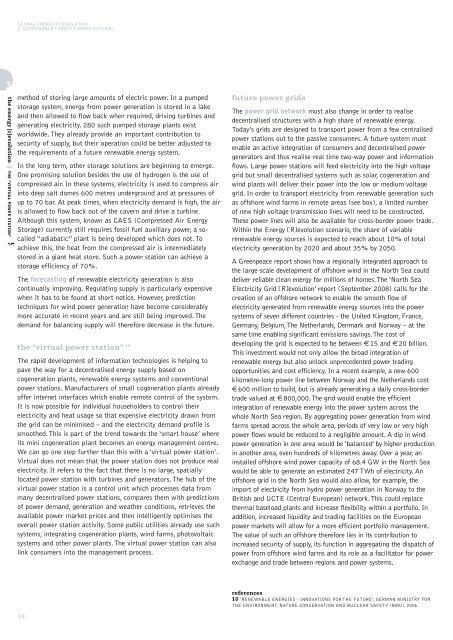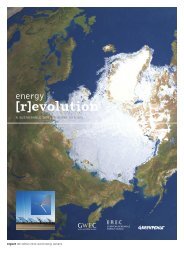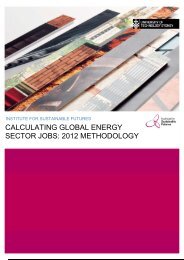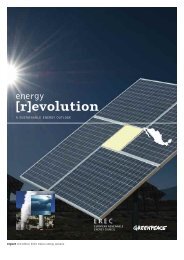download the turkey energy revolution scenario
download the turkey energy revolution scenario
download the turkey energy revolution scenario
You also want an ePaper? Increase the reach of your titles
YUMPU automatically turns print PDFs into web optimized ePapers that Google loves.
GLOBAL ENERGY [R]EVOLUTION<br />
A SUSTAINABLE TURKEY ENERGY OUTLOOK<br />
3<br />
<strong>the</strong> <strong>energy</strong> [r]evolution | THE “VIRTUAL POWER STATION”<br />
method of storing large amounts of electric power. In a pumped<br />
storage system, <strong>energy</strong> from power generation is stored in a lake<br />
and <strong>the</strong>n allowed to flow back when required, driving turbines and<br />
generating electricity. 280 such pumped storage plants exist<br />
worldwide. They already provide an important contribution to<br />
security of supply, but <strong>the</strong>ir operation could be better adjusted to<br />
<strong>the</strong> requirements of a future renewable <strong>energy</strong> system.<br />
In <strong>the</strong> long term, o<strong>the</strong>r storage solutions are beginning to emerge.<br />
One promising solution besides <strong>the</strong> use of hydrogen is <strong>the</strong> use of<br />
compressed air. In <strong>the</strong>se systems, electricity is used to compress air<br />
into deep salt domes 600 metres underground and at pressures of<br />
up to 70 bar. At peak times, when electricity demand is high, <strong>the</strong> air<br />
is allowed to flow back out of <strong>the</strong> cavern and drive a turbine.<br />
Although this system, known as CAES (Compressed Air Energy<br />
Storage) currently still requires fossil fuel auxiliary power, a socalled<br />
“adiabatic” plant is being developed which does not. To<br />
achieve this, <strong>the</strong> heat from <strong>the</strong> compressed air is intermediately<br />
stored in a giant heat store. Such a power station can achieve a<br />
storage efficiency of 70%.<br />
The forecasting of renewable electricity generation is also<br />
continually improving. Regulating supply is particularly expensive<br />
when it has to be found at short notice. However, prediction<br />
techniques for wind power generation have become considerably<br />
more accurate in recent years and are still being improved. The<br />
demand for balancing supply will <strong>the</strong>refore decrease in <strong>the</strong> future.<br />
<strong>the</strong> “virtual power station” 10<br />
The rapid development of information technologies is helping to<br />
pave <strong>the</strong> way for a decentralised <strong>energy</strong> supply based on<br />
cogeneration plants, renewable <strong>energy</strong> systems and conventional<br />
power stations. Manufacturers of small cogeneration plants already<br />
offer internet interfaces which enable remote control of <strong>the</strong> system.<br />
It is now possible for individual householders to control <strong>the</strong>ir<br />
electricity and heat usage so that expensive electricity drawn from<br />
<strong>the</strong> grid can be minimised – and <strong>the</strong> electricity demand profile is<br />
smoo<strong>the</strong>d. This is part of <strong>the</strong> trend towards <strong>the</strong> ‘smart house’ where<br />
its mini cogeneration plant becomes an <strong>energy</strong> management centre.<br />
We can go one step fur<strong>the</strong>r than this with a ‘virtual power station’.<br />
Virtual does not mean that <strong>the</strong> power station does not produce real<br />
electricity. It refers to <strong>the</strong> fact that <strong>the</strong>re is no large, spatially<br />
located power station with turbines and generators. The hub of <strong>the</strong><br />
virtual power station is a control unit which processes data from<br />
many decentralised power stations, compares <strong>the</strong>m with predictions<br />
of power demand, generation and wea<strong>the</strong>r conditions, retrieves <strong>the</strong><br />
available power market prices and <strong>the</strong>n intelligently optimises <strong>the</strong><br />
overall power station activity. Some public utilities already use such<br />
systems, integrating cogeneration plants, wind farms, photovoltaic<br />
systems and o<strong>the</strong>r power plants. The virtual power station can also<br />
link consumers into <strong>the</strong> management process.<br />
future power grids<br />
The power grid network must also change in order to realise<br />
decentralised structures with a high share of renewable <strong>energy</strong>.<br />
Today’s grids are designed to transport power from a few centralised<br />
power stations out to <strong>the</strong> passive consumers. A future system must<br />
enable an active integration of consumers and decentralised power<br />
generators and thus realise real time two-way power and information<br />
flows. Large power stations will feed electricity into <strong>the</strong> high voltage<br />
grid but small decentralised systems such as solar, cogeneration and<br />
wind plants will deliver <strong>the</strong>ir power into <strong>the</strong> low or medium voltage<br />
grid. In order to transport electricity from renewable generation such<br />
as offshore wind farms in remote areas (see box), a limited number<br />
of new high voltage transmission lines will need to be constructed.<br />
These power lines will also be available for cross-border power trade.<br />
Within <strong>the</strong> Energy [R]evolution <strong>scenario</strong>, <strong>the</strong> share of variable<br />
renewable <strong>energy</strong> sources is expected to reach about 10% of total<br />
electricity generation by 2020 and about 35% by 2050.<br />
A Greenpeace report shows how a regionally integrated approach to<br />
<strong>the</strong> large-scale development of offshore wind in <strong>the</strong> North Sea could<br />
deliver reliable clean <strong>energy</strong> for millions of homes. The ‘North Sea<br />
Electricity Grid [R]evolution’ report (September 2008) calls for <strong>the</strong><br />
creation of an offshore network to enable <strong>the</strong> smooth flow of<br />
electricity generated from renewable <strong>energy</strong> sources into <strong>the</strong> power<br />
systems of seven different countries - <strong>the</strong> United Kingdom, France,<br />
Germany, Belgium, The Ne<strong>the</strong>rlands, Denmark and Norway – at <strong>the</strong><br />
same time enabling significant emissions savings. The cost of<br />
developing <strong>the</strong> grid is expected to be between € 15 and € 20 billion.<br />
This investment would not only allow <strong>the</strong> broad integration of<br />
renewable <strong>energy</strong> but also unlock unprecedented power trading<br />
opportunities and cost efficiency. In a recent example, a new 600<br />
kilometre-long power line between Norway and <strong>the</strong> Ne<strong>the</strong>rlands cost<br />
€ 600 million to build, but is already generating a daily cross-border<br />
trade valued at € 800,000. The grid would enable <strong>the</strong> efficient<br />
integration of renewable <strong>energy</strong> into <strong>the</strong> power system across <strong>the</strong><br />
whole North Sea region. By aggregating power generation from wind<br />
farms spread across <strong>the</strong> whole area, periods of very low or very high<br />
power flows would be reduced to a negligible amount. A dip in wind<br />
power generation in one area would be ‘balanced’ by higher production<br />
in ano<strong>the</strong>r area, even hundreds of kilometres away. Over a year, an<br />
installed offshore wind power capacity of 68.4 GW in <strong>the</strong> North Sea<br />
would be able to generate an estimated 247 TWh of electricity. An<br />
offshore grid in <strong>the</strong> North Sea would also allow, for example, <strong>the</strong><br />
import of electricity from hydro power generation in Norway to <strong>the</strong><br />
British and UCTE (Central European) network. This could replace<br />
<strong>the</strong>rmal baseload plants and increase flexibility within a portfolio. In<br />
addition, increased liquidity and trading facilities on <strong>the</strong> European<br />
power markets will allow for a more efficient portfolio management.<br />
The value of such an offshore <strong>the</strong>refore lies in its contribution to<br />
increased security of supply, its function in aggregating <strong>the</strong> dispatch of<br />
power from offshore wind farms and its role as a facilitator for power<br />
exchange and trade between regions and power systems.<br />
18<br />
references<br />
10 ‘RENEWABLE ENERGIES - INNOVATIONS FOR THE FUTURE’, GERMAN MINISTRY FOR<br />
THE ENVIRONMENT, NATURE CONSERVATION AND NUCLEAR SAFETY (BMU), 2006



![Energy [R]evolution - European Commission](https://img.yumpu.com/49109324/1/184x260/energy-revolution-european-commission.jpg?quality=85)


![5905 gp [eu rev]csfr4.qxd - Energy [R]evolution](https://img.yumpu.com/42305023/1/184x260/5905-gp-eu-revcsfr4qxd-energy-revolution.jpg?quality=85)

![5905 gp [eu rev]csfr4.qxd - Energy [R]evolution](https://img.yumpu.com/28729264/1/184x260/5905-gp-eu-revcsfr4qxd-energy-revolution.jpg?quality=85)
